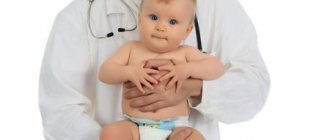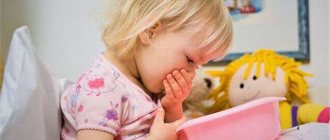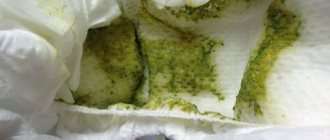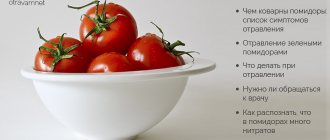When a baby appears in the family, all the parents' attention is focused on him. A wise mother will pay special attention to the color and nature of feces, because in a newborn age this is an important indicator of the body’s functioning. For what reasons can a baby develop diarrhea with mucus? How to properly help a baby?
Can this phenomenon be considered normal?
The appearance of loose stools with mucus in newborns can be considered normal. In the first days of life, the baby produces original feces, which is called meconium. It consists of bile, mucus, water, epithelial cells, amniotic fluid, which the fetus swallowed during intrauterine development.
Meconium masses are formed before birth and are expelled within the first three days after the baby is born.
Mucus and diarrhea are also normal if the child is teething. This first occurs at the age of 4-5 months. In this case, diarrhea is accompanied by an increase in body temperature and a change in the behavior of the child, who becomes restless, often cries, and sleeps poorly.
If diarrhea with mucus is observed as isolated cases that occur from time to time, then there is no reason to worry. But, if diarrhea with mucous masses does not go away during the day and is frequent, you should urgently consult a doctor.
In infants
The presence of blood in a baby's liquefied stool is a manifestation of damage to his intestines by bacteria, viruses, worms or other factors. The child may cry from abdominal pain. His temperature may rise and vomiting may begin.
Such symptoms should be a cause for concern for any mother.
It is important to call a doctor for an infant as soon as possible, and not to treat the baby yourself, since diarrhea in an infant under one year old is especially dangerous due to rapidly developing dehydration.
Risk factors
The causes of diarrhea with mucus in babies are:
- Poor nutrition. If the child is breastfed, then diarrhea with mucus may occur with an unclear diet. Thus, the stomach becomes irritated if the interval between meals is too short or long;
- Infectious diseases. Loose stools and the appearance of mucus in the stool are characteristic of salmonellosis. In addition to diarrhea, an increase in body temperature is observed. The stool is green in color. Also, loose stools with mucus occur with intestinal dysbiosis, rotavirus infection and dysentery;
- Incorrect introduction of complementary foods. Complementary feeding should begin no earlier than 6 months of age. To avoid intestinal upset, you should not start complementary feeding with the introduction of juices, purees of vegetables and fruits;
- The body's reaction to taking certain medications. Most often, diarrhea with mucus appears due to the mother taking medications, the active substances of which penetrate into breast milk. Antibiotics and antipyretics also cause bowel problems;
- Maternal malnutrition. A breastfeeding woman needs to especially carefully monitor her diet. It is important to exclude allergens, as well as products that cause increased gas formation. It is strictly forbidden to consume low-quality products, as well as those whose validity period has expired;
- Intolerance to certain products;
- Runny nose. If a child gets sick, he produces snot, which he can swallow. Thus, they penetrate the esophagus, and mucus appears in the stool;
- Congenital pathologies of the digestive system;
- Binge eating. This occurs when the feeding regime is violated;
- Emotional overexcitement;
- Change of usual climatic conditions.
The volume, consistency and color of mucus may also indicate the cause of diarrhea:
- If the mucus is clear and present in small quantities, this usually indicates inflammation of the intestinal walls caused by an infectious agent;
- Green diarrhea with mucus is the result of the penetration of pathogenic bacteria into the gastrointestinal tract. Under such conditions, traces of blood may also appear in the stool;
- White foamy mucus. This phenomenon is typical for intestinal infections, as well as helminthic infestations;
- Black slime. This color indicates severe abnormalities, for example, the development of a malignant tumor, polyps, dilation of the esophageal veins;
- Pink-red mucus in the stool during diarrhea indicates intestinal diseases, which are accompanied by internal bleeding;
- Yellow mucus with an unpleasant odor indicates enzyme deficiency, digestive tract infections, and helminthiasis.
Note! The more mucus in a child’s stool, the more pronounced the inflammatory process in the body.
If a child has diarrhea and mucus with traces of blood is observed, this indicates either congenital anomalies or acquired intestinal infections in an advanced stage. The appearance of blood indicates inflammatory damage to the intestinal mucosa and its rejection. In such cases, you must act immediately: urgent medical attention is required.
Additional manifestations may also occur. Symptoms accompanying diarrhea with mucus in a child are:
- stomach ache;
- vomit;
- general weakness;
- the appearance of greenish or white flakes in the stool.
With diarrhea, the frequency of bowel movements is 10 or more times a day.
Preventive actions
Maintaining basic hygiene rules and nutritious nutrition is all that is required for the good health of your child. To prevent possible episodes of bloody diarrhea, you must:
- Provide the child with quality nutrition in accordance with his age and body needs. The diet should not contain mushrooms, seafood, sausages and other similar products. The same applies to finished products and semi-finished products stuffed with dyes, flavors and flavor enhancers.
- Boost your child’s immunity to reduce the risk of contracting infectious diseases. Regular walks in the fresh air, moderate physical activity, swimming or hardening - all this is perfect for building a strong immune system.
- From childhood, teach children to follow basic hygiene rules - washing hands before eating, after walking and going to the toilet.
- Be sure to boil water used for drinking.
- All vegetables, berries and fruits must be thoroughly washed before consumption. Raw meat, fish and eggs must undergo full heat treatment.
- Do not allow your child to swim in questionable bodies of water.
- Try to limit contact with sick children.
But the best prevention of any disease is breastfeeding. By maintaining lactation, the mother gives the child a chance to grow strong and healthy.
In what cases should you consult a doctor?
You should consult a doctor if you have diarrhea with mucus in the following cases:
- bright green tint of stool;
- regurgitation, which accompanies diarrhea and occurs after every meal;
- foamy or watery stools;
- high temperature accompanied by diarrhea;
- loss of appetite;
- dry mucous membranes;
- a sharp decrease in body weight;
- strong thirst;
- excessive pallor and stickiness of the skin;
- rare urination and small volumes of urine;
- mucus in the stool along with blood;
- the acrid and fetid odor that comes from the baby's stool.
Important! You should also consult a doctor if your child shows signs of an acute respiratory illness due to diarrhea. This combination of symptoms usually indicates intestinal infections that develop rapidly.
First aid for a baby
If blood appears in diarrhea, parents should know what needs to be done to improve the baby’s health. Algorithm of actions:
- call a doctor;
- do not get rid of feces until a specialist arrives - this is necessary in order to show the doctor the contents;
- do not feed the baby;
- Give your baby a drink every 5 minutes, but in small portions;
- at elevated temperatures, give the child a drug containing paracetamol in the form of suppositories or syrup (analgin-containing drugs are not allowed to be taken under 12 years of age);
- do not forget to wash your baby after each bowel movement;
- Give the patient Enterosgel, Smecta or Polysorb - they will help remove toxins from the body.
We recommend: When and what temperature should you lower in a child?
Diagnostics
In order to determine the cause of diarrhea with mucous masses, the following diagnostic measures are prescribed:
- coprogram to determine the cause of disorders of the gastrointestinal tract and pancreatic functions;
- general blood test to assess the intensity of the inflammatory process;
- stool analysis for the content of worm eggs;
- analysis of stool for dysbacteriosis;
- bacterial culture for staphylococcus, rotavirus, pathogens of the dysenteric and paratyphoid groups;
- Ultrasound of the gastrointestinal tract.
After the diagnosis is made, treatment of the child begins immediately. The course of therapy depends on the identified pathology.
Mode during recovery
Proper recovery from diarrhea helps the baby return to a full life. The duration of rehabilitation therapy largely depends on what caused the disease. If it is caused by a digestive disorder, a gentle diet is required for a month and restoration of the intestinal microflora with the help of preparations containing beneficial bacteria.
When stool disorder is caused by infection, the intestinal mucosa remains inflamed for a long time. Children are advised to have a gentle diet, eat small portions, and adhere to the drinking regime.
After viral and bacterial infections or taking antibiotics, enzymatic preparations that improve digestion (Festal, Creon, Pancreatin, etc.) are prescribed. Doctors also recommend drugs for dysbiosis.
Treatment
Self-treatment of diarrhea with mucus in children is unacceptable. Therapy should be carried out only under the supervision of the attending physician.
To relieve the symptoms of intestinal disorders, infants are most often prescribed the drug Smecta. The product promotes consolidation and prevents digested food from being quickly removed. Another sorbent drug used in pediatrics is Atoxil.
For a bacterial infection that has caused a gastrointestinal tract disorder, an antibacterial drug is prescribed taking into account the sensitivity of the pathogen that has entered the child’s body.
Also, in case of diarrhea, children are given probiotics - products that normalize the intestinal microflora. These are Bifidum-Bakterin, Enterol, Lactovit.
In order to prevent the possibility of dehydration of the child’s body, you need to give him a special solution. It is prepared as follows: in a liter of water, previously boiled and cooled, dissolve 2 tablespoons of sugar, as well as a teaspoon of table salt and the same amount of soda. The baby should be given the resulting solution every 10 minutes. Single quantity – 2 teaspoons.
You can give a solution with sugar, salt and soda only on the recommendation of a doctor.
Instead of a solution, infusions of chamomile or mint are also used to replenish fluid. Another recipe is rice or pomegranate broth.
In addition, to restore the water-salt balance, products such as Oralit or Acesol are used.
If the child is already at the complementary feeding stage, then it is necessary to exclude from his diet foods that are difficult to digest. These are fruit juices and a variety of dairy products. It is recommended that babies who are bottle-fed be switched to soy mixtures.
Important! The mother should also adjust the diet and exclude from it foods that can disrupt the functionality of the intestines.
Useful tips
The mother can only help the child by constantly feeding him warm water, chamomile decoction or rehydron. Strict control over the nutrition of the nursing mother so as not to provoke a deterioration of the condition. Do not change the foods or formula that were given to the child before the appearance of pathological stool.
Allowed to use:
- Rice water.
- A weak solution of potassium permanganate.
- Sweetened jelly.
You can give medications or herbal decoctions only with the permission of a doctor. Some of them can be dangerous to health, so, as with medicines, you need to be careful with them. After six months, a child’s diet should consist of boiled carrots, oatmeal cooked in water, and grated rice porridge.
Complications
If timely measures are not taken when a baby develops diarrhea with mucus, this can have dangerous consequences. These include the following:
- dehydration of the body. This is a very dangerous condition that leads to convulsions and loss of consciousness and can even cause death;
- rectal prolapse. This can happen if dysentery is ignored or insufficiently treated;
- chronic intestinal disorders: constant bloating, frequent diarrhea and constipation;
- anemia;
- progressive intoxication;
- development of lactase deficiency.
Since the possible complications are truly severe, you should consult a doctor at the first disturbance in the functioning of the digestive system.
Prevention
To reduce the risk of diarrhea with mucus in a child, you should follow these recommendations:
- A nursing mother should eat healthy foods and avoid those foods and dishes that can negatively affect the general condition of the baby. All food must be fresh and of high quality;
- the child should receive regular nutrition. The feeding regimen should be balanced: both overeating and starvation should not be allowed. Complementary foods must be introduced gradually;
- If possible, the child should be fed naturally, without the use of artificial formula;
- if it is necessary to treat a child with antibiotics, it is imperative to supplement the treatment with probiotics;
- from early childhood, you should strengthen the child’s immunity, perform simple physical exercises, introduce the baby to water;
- The water that the baby drinks must be boiled first.
Diarrhea with mucus is a phenomenon that is not always associated with serious pathologies. Sometimes it is a normal variant and is caused by the release of meconium. If diarrhea with mucus persists for several days, you should consult a doctor for a diagnosis.
What and how to treat
After the diagnosis, the gastroenterologist or pediatrician (depending on the diagnosis) will tell you exactly how to treat bloody diarrhea in a child. If we are talking about an infection, doctors recommend protecting the baby from contact with other people in order to avoid an epidemic.
Diet
In addition to drug treatment, the child will be prescribed a diet in which:
All foods that are difficult to digest are excluded:
Easily digestible foods are added to the diet:
Water consumption also increases.
If there is diarrhea in a one-month-old baby or in a baby under two years old, who is still being fed by the mother, she goes on a similar diet, while lactation continues. For “artificial” dieters, doctors recommend switching to soy-based mixtures.
Medicines
Drug treatment for bloody diarrhea is prescribed depending on the diagnosis:
- In case of poisoning. In this case, doctors recommend removing toxins with enterosorbents (activated carbon).
- In case of bacterial infection. The child will be prescribed antibiotics (Ciprofloxacin, it can only be given to children from the age of five).
- For dysbacteriosis. To restore the intestinal microflora, pre- and probiotics are prescribed (Bifiform - from 1 year).
The photo shows medications prescribed for the treatment of bloody diarrhea.
Folk remedies
As an additional treatment, after consulting a doctor, you can try folk remedies.
| Name | Recipe | Application |
| Collection of herbs | Peppermint leaves, blueberries, knotweed rhizomes, chamomile flowers. To prepare the infusion, you will need to pour 0.5 liters of boiling water over the berries and herbs and let it brew. | It is recommended to drink the decoction warm half an hour before meals 3-4 times a day |
| Pomegranate peel | It must be dried, brewed 1 teaspoon per glass of water, boil the infusion for 15 minutes on the stove, leave in a warm place for 2 hours and strain. | You can give your child the decoction before meals three times a day, one tablespoon at a time. For children under three years of age, the dose is reduced to a teaspoon. |
| Starch | A teaspoon of starch is dissolved in 0.5 cups of boiled water or boiled like jelly. | The child should be given a glass of water 2-3 times a day. |











